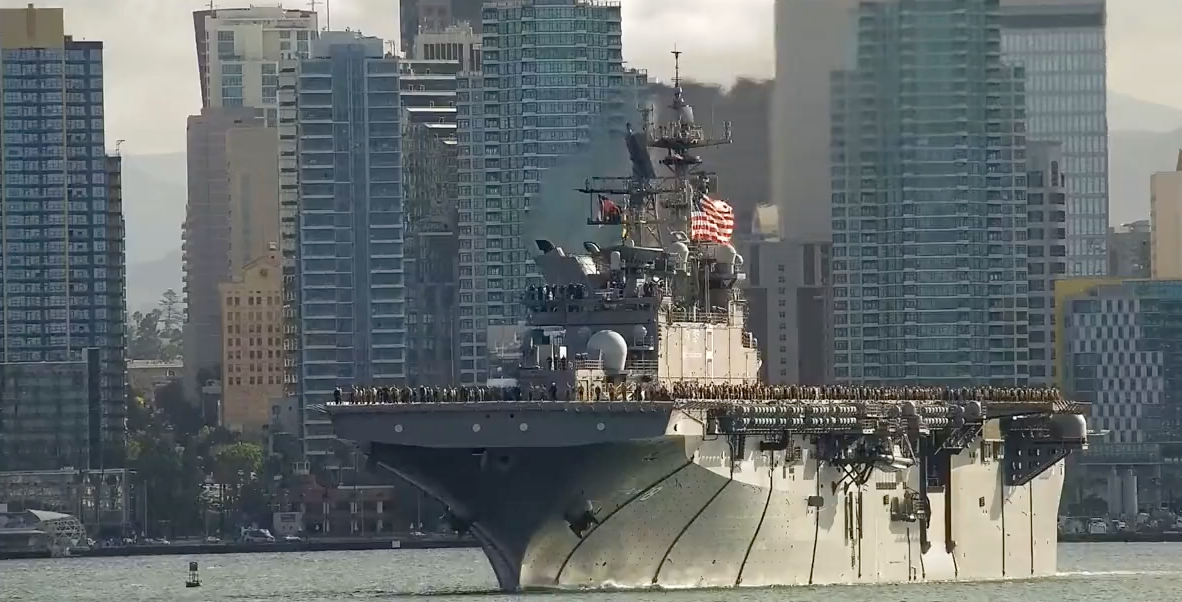
USS Makin Island (LHD-8) leaves San Diego Harbor on Nov. 9, 2022 for an Indo-Pacific deployment. Photo via San Diego Web Cam used with permission
Amphibious assault ship USS Makin Island (LHD-8), the flagship of the Makin Island Amphibious Ready Group, left Naval Base San Diego on Wednesday for a deployment to the Indo-Pacific region, USNI News has learned.
The Amphibious Ready Group with the 13th Marine Expeditionary Unit embarked includes Makin Island and amphibious transport docks USS John P. Murtha (LPD-26) and USS Anchorage (LPD-23). Makin Island and John P. Murtha left San Diego on Wednesday, while Anchorage left on Tuesday.
The ARG/MEU includes the aviation combat element with the “Flying Leathernecks” of Marine Fighter Attack Squadron (VMFA) 122 flying F-35B Lightning II Joint Strike Fighters and the “Ugly Angels” of Marine Medium Tiltrotor Squadron 362 (Reinforced) flying MV-22B Ospreys; the logistics combat element made up of Combat Logistics Battalion 13; and the ground combat element with 2nd Battalion, 4th Marines.
USNI News was aboard Makin Island this summer during its Amphibious Squadron Marine Expeditionary Unit Integration Training (PMINT) phase, when sailors and Marines first come together for at-sea training ahead of deployment. Leaders on the amphibious assault ship emphasized the crew’s focus on learning how to operate a full squadron of Marine Corps F-35Bs aboard Makin Island.
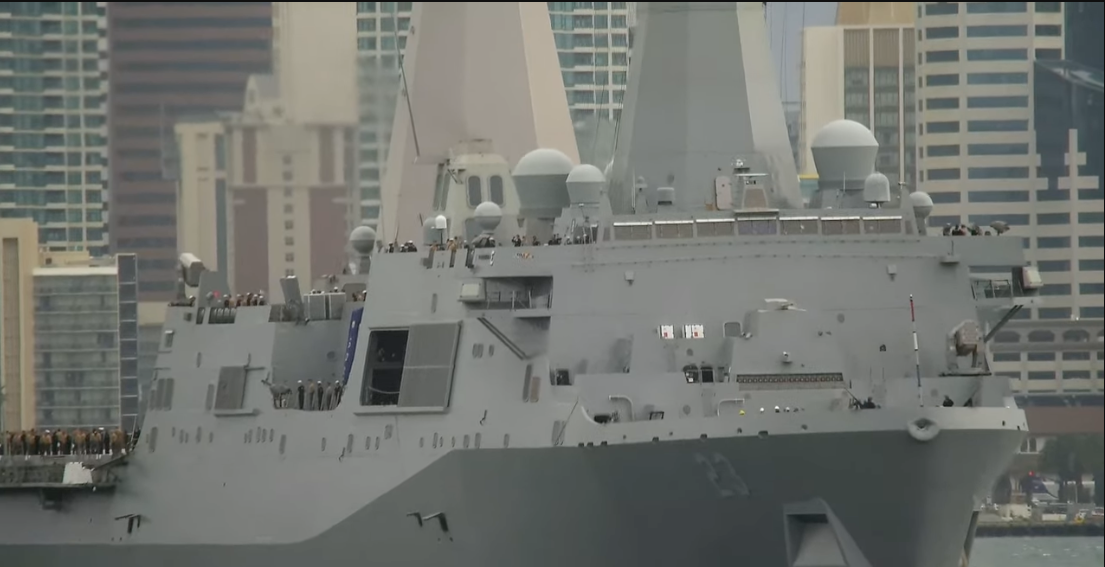
Sailors and Marines aboard USS Anchorage (LPD-23) man the rails as the ship leaves San Diego harbor on Nov. 8, 2022. Photo via San Diego Web Cam used with permission
“This ship, with this MEU, with these aircraft, is an example of how we push naval integration forward and we’re literally writing the book right now, as you see cruiser-destroyer surface warfare officers that are executive officers of this ship, an aviator that is the [commanding officer] of this ship, an aviator that is the MEU commander – look at what our higher leaders want and then try to put two and two together and offer solutions. And that is the unique thing about this PMINT and this workup with these forces and with this ship,” Col. Samuel Meyer, the commanding officer of the 13th MEU, told USNI News at the time.
The West Coast-based MEU is expected to operate in the Indo-Pacific, the Navy’s operational focus over the last few years amid heightened tensions with China over Taiwan.
“We have certain ways that we’ll act while we’re at sea and the way we’ll prepare for that during PMINT potentially is [to] kind of take that into consideration. What are we seeing from China? And then we’ll prepare appropriately,” Capt. Tony Chavez, an aviator and the commanding officer of Makin Island, told USNI News when asked how the Pentagon’s emphasis on conflict with a near-peer threat has trickled into the training phase.
Preparing for Deployment
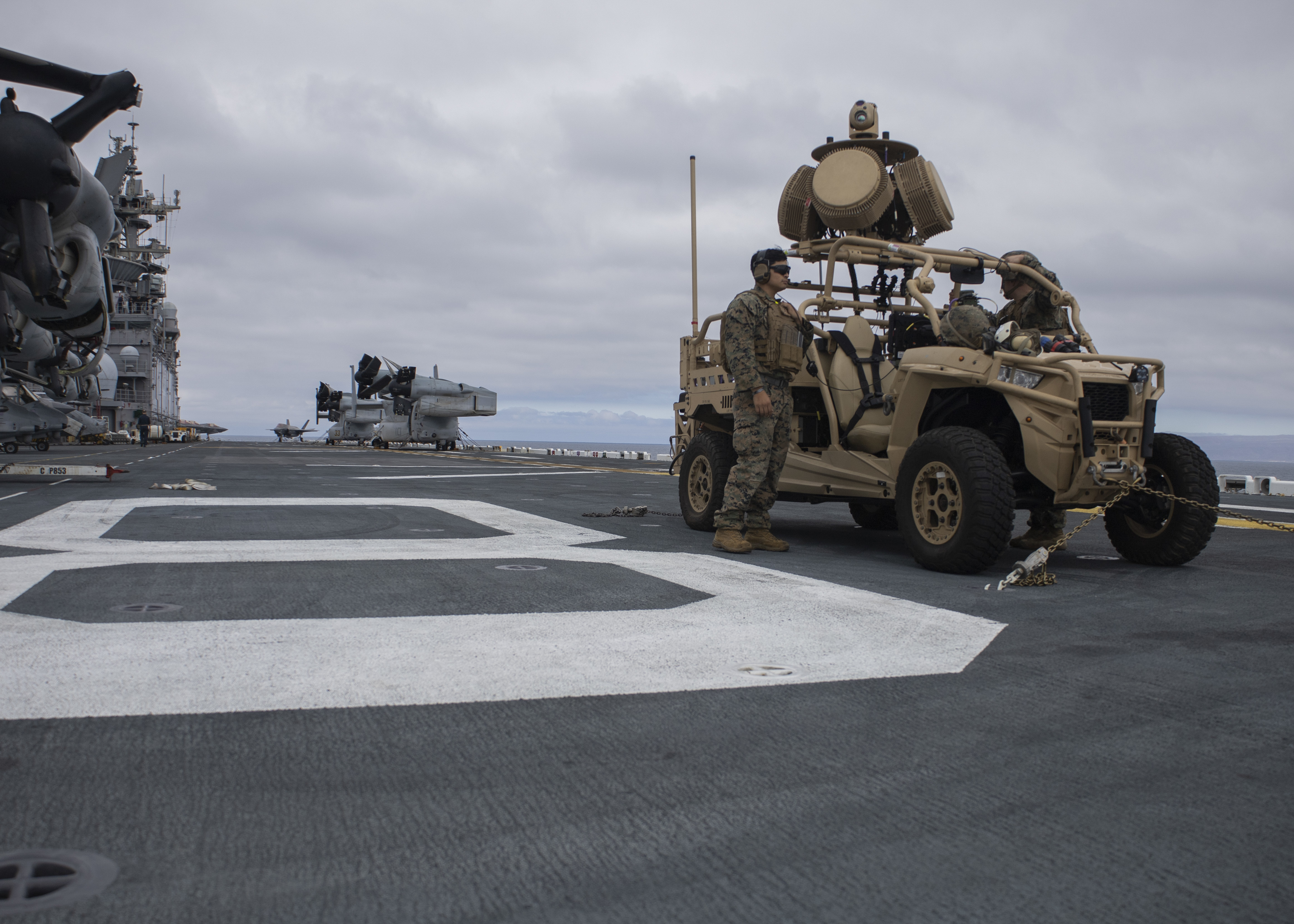
Marines with Marine Medium Tiltrotor Squadron (VMM) 362 (Reinforced) operate a Light Marine Air Defense Integrated System during Defense of the Amphibious Task Force exercise aboard amphibious assault ship USS Makin Island (LHD-8) on July 13, 2022. US Marine Corps Photo
Officials described PMINT as the “crawl” phase of gearing up for deployment. ARG/MEU Exercise, the amphibious ship community’s version of the aircraft carrier’s Composite Unit Training Phase (COMPTUEX), follows the PMINT stage.
The initial at-sea training period allows sailors and Marines to evaluate the mix of equipment the ARG/MEU will take on deployment and integrate procedures for how the crew will operate those platforms together.
“How all that mix[es] and how everything fits, it’s almost like professional Jenga. And so you’re not only playing it with the equipment, you’re also playing it with the policies and procedures to ensure safety and to ensure that we are efficient and lethal as well,” Capt. Andria Slough, Makin Island’s executive officer, told USNI News.
For example, when planning for PMINT the Navy sent sailors to Yuma, Ariz., to learn how to handle the Marine Corps’ MV-22Bs.
During the PMINT phase, the crew also has more time to work with the platforms and equipment and refine procedures, since it’s not yet operating in deployment-like conditions.
“So if we didn’t like it, it’s like, okay do-over. Go back again. And we’ve done it with some of our V-22s, some of our F-35s,” Slough said. “Not that anything’s wrong, but [it’s] ‘hey we think we can do that a little bit better.’ And so we go back and do that.”
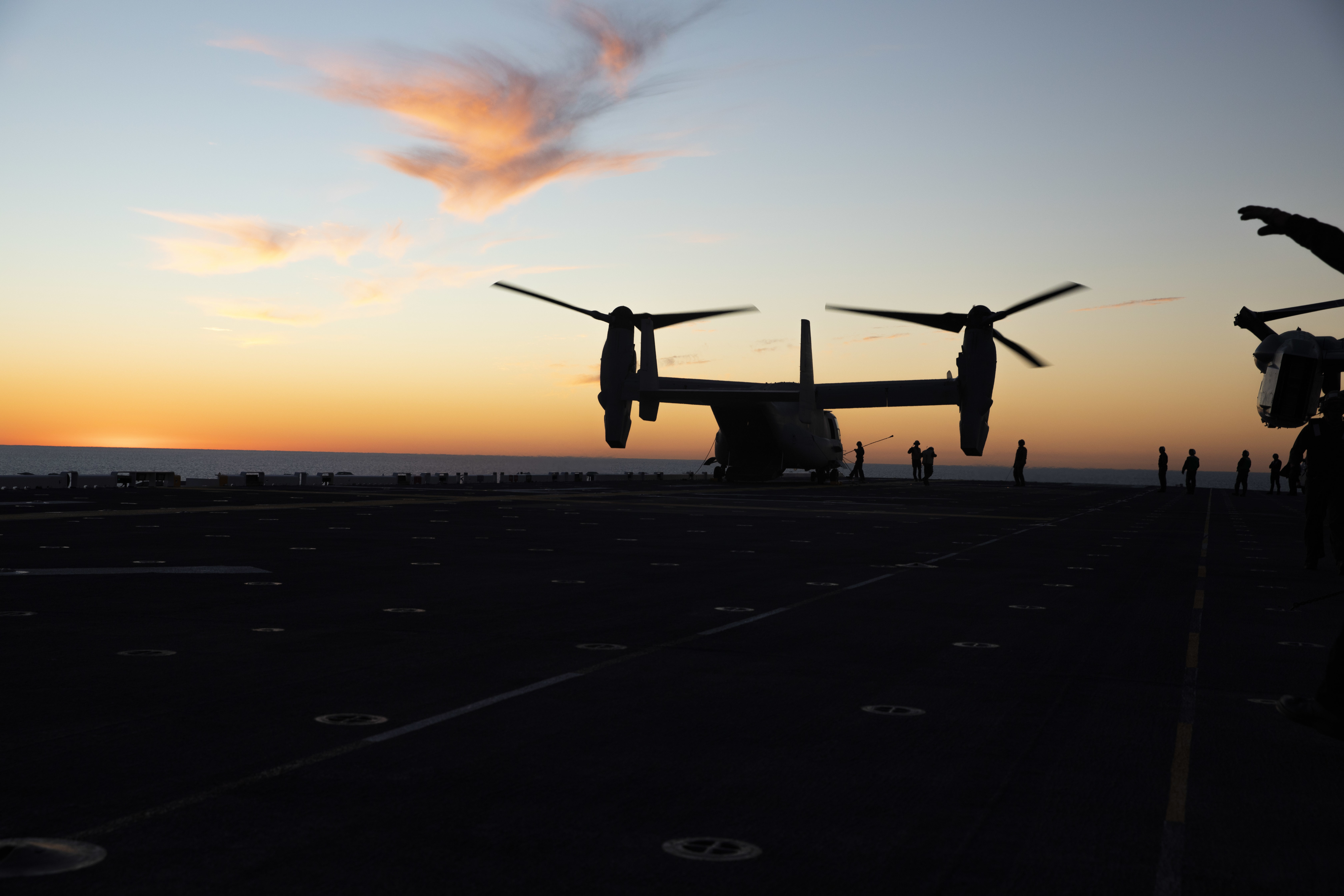
An MV-22 Osprey, assigned to Marine Medium Tiltrotor Squadron (VMM) 362, idles on the flight deck of amphibious assault ship USS Makin Island (LHD-8), Feb. 4, 2022. US Navy Photo
The PMINT phase also allows Marines to get a better understanding of life on a ship, like understanding how man overboard drills work and enforcing the requirement to make their beds.
“Obviously the Marines have been on land for a long time and what I’m seeing is that … only a very small portion of the MEU that’s onboard now has been out to sea any time. So obviously we’re relearning that integration piece, so it’s going to be key,” Chavez said.
“But the ability to make sure that we can put Marines ashore and be able to be effective at that and then to continuously support the power projection and sea control is going to be key for us. And that’s where I think the integration piece is going to be effective.”
That integration has been a focus for the Navy and Marine Corps as they prepare for conflict in the vast waters of the Indo-Pacific and adjust to Commandant Gen. David Berger’s push for a lighter Marine Corps focused on an island-hopping campaign to quickly threaten enemy ships and amphibious capabilities.
“With this ship, we are exploring how the Navy and the Marine Corps integrate today. So Force Design for the commandant, what does that look like, how do we posture to compete in an environment that’s different than we had before. So we’ve brought different capabilities on the ship,” Meyer told USNI News.
“We have more F-35Bs. We studied the connector mix, meaning you’ve seen [Landing Craft Air Cushions], landing craft, things like that, and work with the ship to say, ‘the ship’s not going to get any bigger, but we want to bring more and different things,’” he added. “So I rely on this relationship with this ship to say what is the optimized mix of things that will allow us to defend ourselves and integrate my systems with their systems. And as time changes and systems change, that’s how naval integration changes.”
F-35B
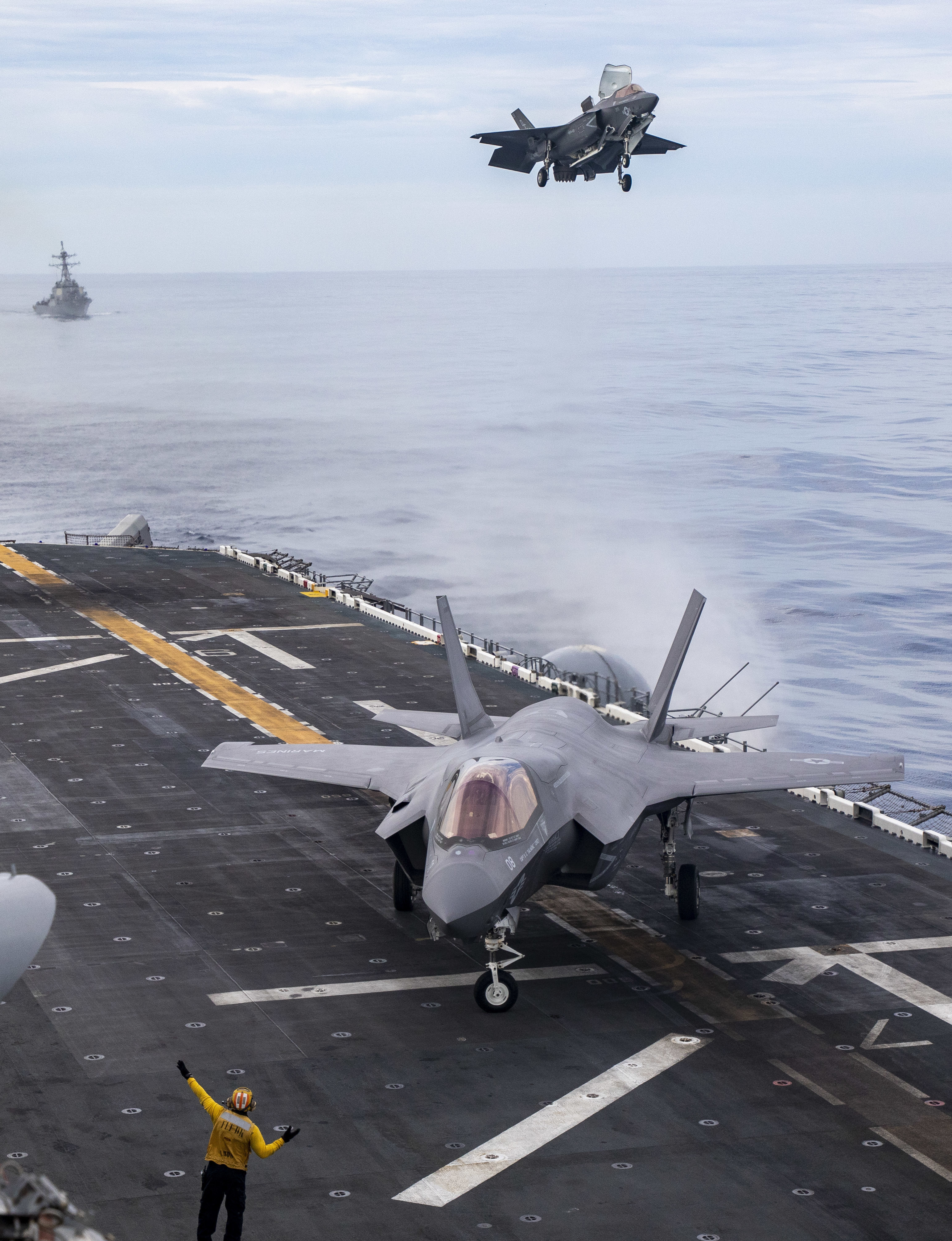
Marine F-35B Lighting II pilots with Marine Fighter Attack Squadron (VMFA) 122, 13th Marine Expeditionary Unit, land aboard amphibious assault ship USS Makin Island (LHD-8) on Sept. 4, 2022. US Marine Corps
Makin Island is deploying with a full squadron of F-35Bs, or 10 aircraft. While it’s not the first amphibious assault ship to do so, the deployment will help the Navy and Marine Corps get a better sense of both the deck handling required for full squadron and how to operationally employ one.
“We are still working through what that looks like. So all the training, there’s evolutions in how we move things on and around the flight deck. And It’s an evolutionary capability, I won’t say revolutionary because the ship did deploy with some last time. But we’re looking to see what the right mix between F-35s and MV-22 looks like,” Meyer said.
To figure out how the ARG/MEU will employ the short take-off and vertical landing variant of the fifth-generation fighter, the crew worked with both Navy and Marine Corps warfare tactics instructors.
“We are really just working through what this looks like because there’s not a lot of documentation on how to fight a squadron of them,” Slough said. “And so we’re working all that out and then in addition, we’re working our flight deck sequencing out so we can deploy the maximum amount of those aircraft at one time for the threats that come up.”
With more aircraft aboard Makin Island for this deployment, the crew is wrestling with the ship’s deck density and learning how to effectively move aircraft around the flight deck.
“The challenge is you have limited space, obviously. So put more things onto the flight deck, that is inherently harder. You have less space to work with so the risk is higher. The risk of damaging aircraft … is higher,” Cmdr. Donald Emerson, Makin Island‘s air boss, told USNI News. “I would say, the manning that I have in the air department is built for a certain number of aircraft and we need more people. I mean, we’ve proved that we can do it. We can do it safely.”
Since the ship can’t launch MV-22Bs at the same time as F-35Bs, it has to be strategic when planning the launches.
“I think the big challenge is with less space, we’ve got aircraft living in the landing areas. So we have to move those aircraft when we need the spots,” Emerson said. “More aircraft equals more moves.”
ACV Certifications
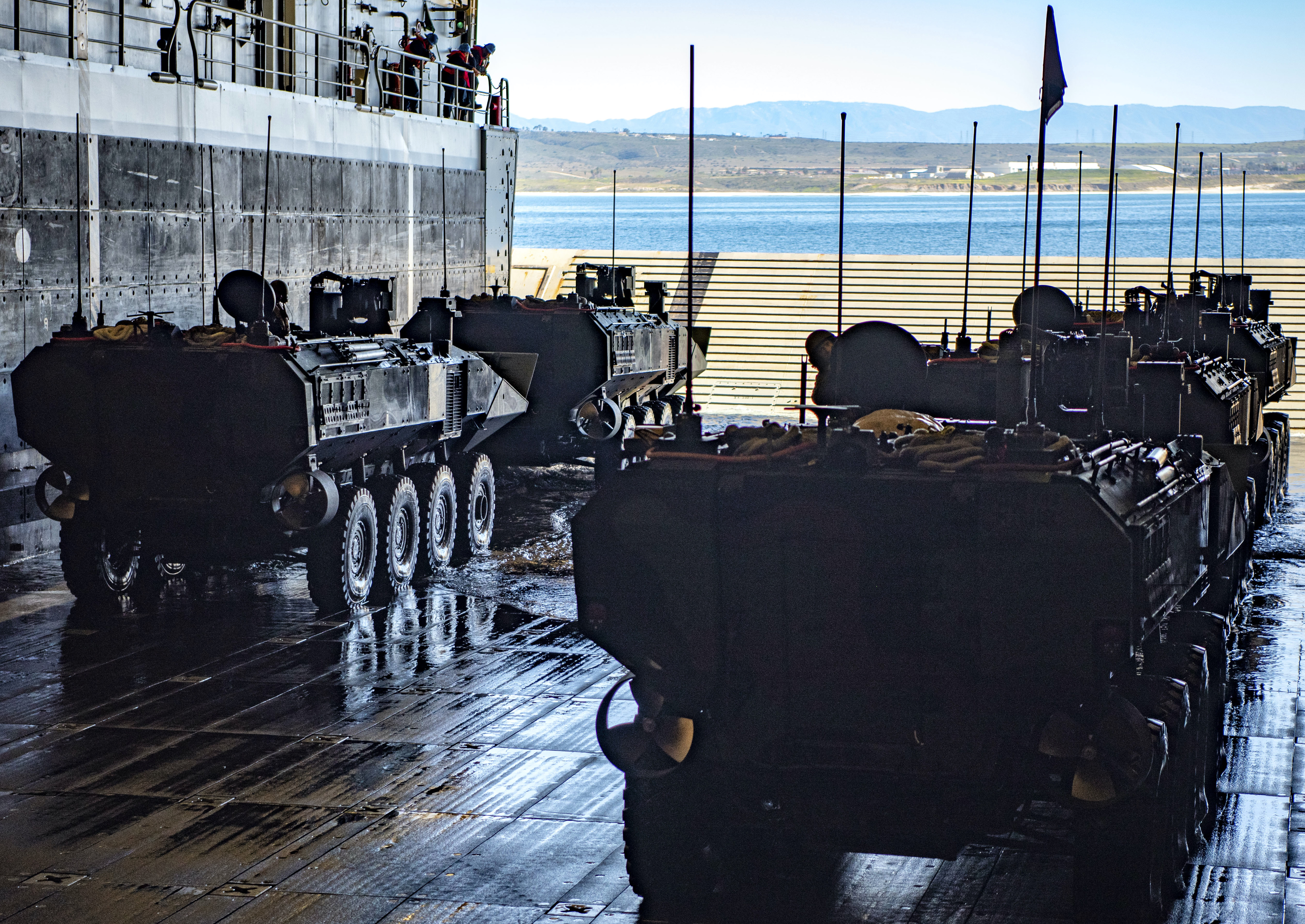
Marines assigned to the 3rd Assault Amphibian Battalion, 1st Marine Division conduct waterborne training with Amphibious Combat Vehicles (ACV) aboard amphibious transport dock ship USS Anchorage (LPD-23) in the Pacific Ocean, on Feb. 13, 2022. US Navy Photo
Makin Island is the first big-deck amphibious warship to become certified for the Marine Corps’ new Amphibious Combat Vehicle.
During PMINT, the three ships in the ARG each earned certifications to operate the ACVs, which will replace the aging Assault Amphibious Vehicle. To prepare for ACV operations, the Navy sent two buses of sailors to Camp Pendleton, Calif., to learn how to operate the ACVs, Slough told USNI News in July.
Once the Marine Corps brought the ACV to Naval Base San Diego, sailors with the Makin Island ARG had the chance to get their hands on the platform to better understand how it works.
“Then they brought it to Makin Island while we were tied up at the pier. And we drove it around and we took measurements and made sure everything fit,” Slough said.
“And then after that we did a very very slow, very controlled practice in a very calm environment where we had Makin Island very close to sure and the ACVs came out under extra safety controls and extra supervision and did that. And then our last one, we still had the supervision, but we moved it away a little bit just to give us a little bit of room. And then we executed our certification.”
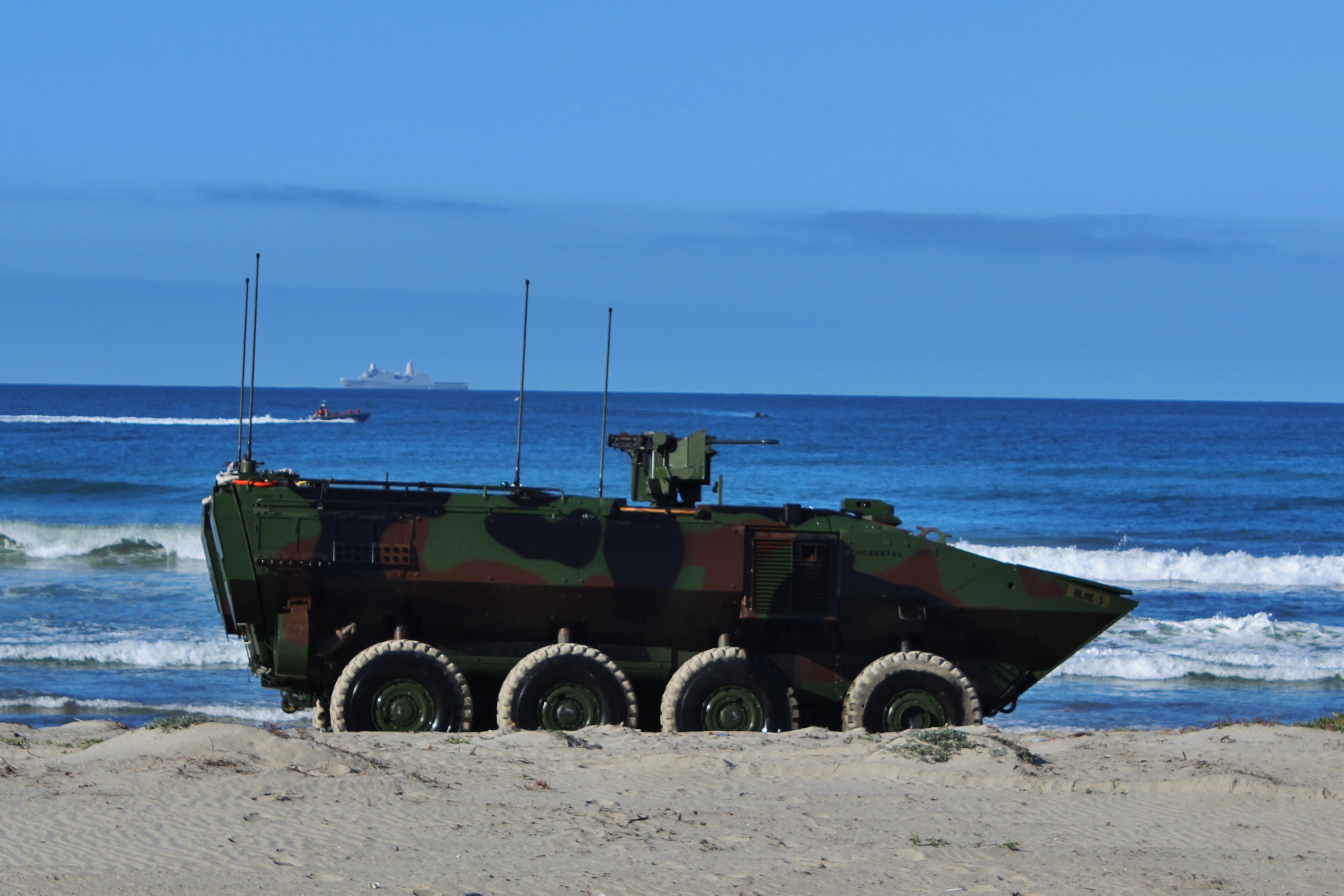
An ACV with 3d Assault Amphibian Battalion, 1st Marine Division onshore and USS Anchorage (LPD-23) and two Navy safety boats in the water. USNI News Photo
While each ship successfully completed the certifications, the Marine Corps in August delayed the first ACV deployment after a July incident in which two vehicles were knocked off their wheels in heavy surf near Camp Pendleton, Calif., USNI News first reported.
The 15th MEU, also based at Camp Pendleton, is now slated to execute the first ACV deployment, Marine Corps deputy commandant for combat development and integration Lt. Gen. Karsten Heckl told USNI News in September.
“Meanwhile, we will continue to pursue more testing, more data in higher surf zones with, I believe it’s medium surf index, so that we can have a [clearer] understanding of what sea states of six and up to eight would mean,” Heckl said.
from JC’s Naval, Maritime and Military News https://ift.tt/8sXFuJx
via IFTTT
Leave a comment